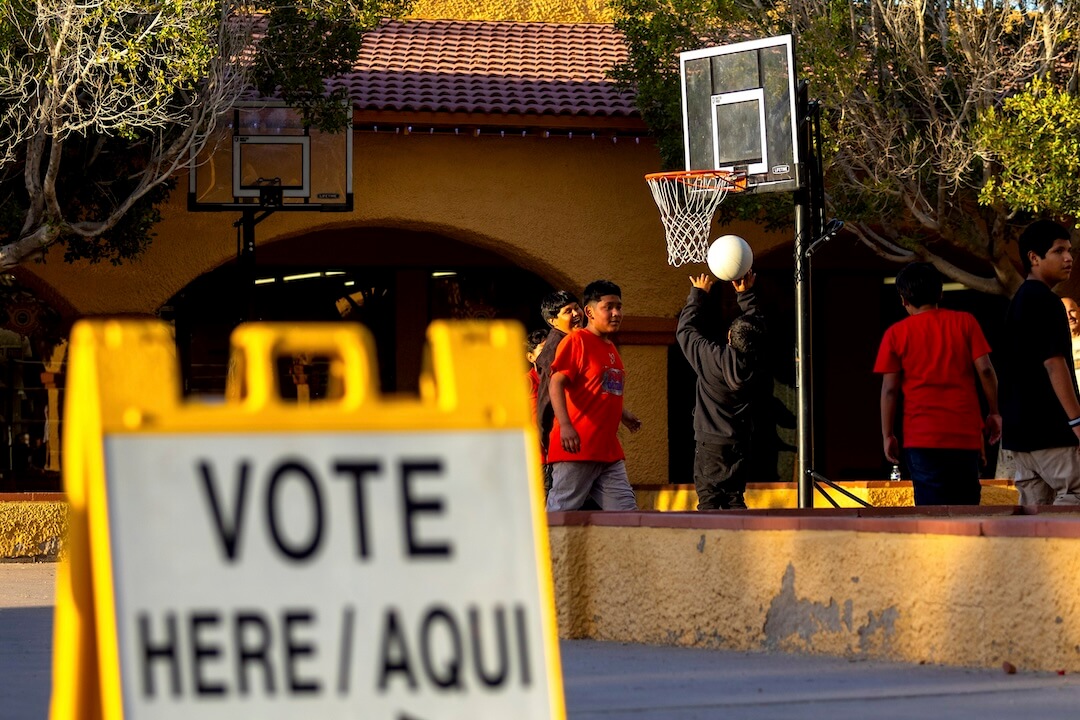The presidential candidates are heavily courting Latino voters in 2024, a year in which some polls show this voting bloc’s support may be more up for grabs than at any point in at least two decades.
Historically, Latino voters have backed Democrats, though that differs by place of ancestry. For example, a majority of Cuban Americans identify as Republicans, Pew Research Center data shows, while Mexicans and Puerto Ricans tend to lean Democratic.
In 2020, Joe Biden won 65% of Latino voters, compared with 32% for Donald Trump, according to the national exit poll. Latino support for the Democratic presidential nominee has fallen below 60% only twice in the past half century, exit polls show: 59% in 1980 and 53% in 2004.
Could this year be different? Some polls show Latino support for Biden as low as 40%. When given a third-party option, one poll sponsored by Voto Latino, a Latino advocacy group, found Biden at 47%, Trump at 34% and third-party candidates collectively taking 17%.
During the June 27 debate, Trump made a play for Latino voters, blaming Biden for high inflation, which he said is “killing Black families and Hispanic families.” He added that Biden’s economic policies are “taking Black jobs and they’re taking Hispanic jobs” and that Biden has “done a horrible job for Hispanics.”
Biden, by contrast, has touted his policies’ positive impact on Latinos. At a campaign event in March in Phoenix, he said, “We achieved the lowest unemployment rate for Latinos in a long, long time. We cut Hispanic child poverty to record lows. We lowered the health care costs. We made historic investments in Latino small businesses.”
At a White House reception for the Mexican holiday Cinco de Mayo, Biden said his administration had “expanded health coverage through the Affordable Care Act, doubling the number of Latinos enrolled since 2020.”
Does either candidate have a clear edge on boosting the economy for Latino voters? We decided to take a close look, much as we did June 25 with the question of how Black Americans have experienced the economy under both presidents.
In our analysis of the economy for Black Americans, we concluded that — setting aside the immediate coronavirus pandemic era, which skewed some economic statistics — Black Americans fared well by historical standards during Donald Trump’s presidency but fared even better under President Joe Biden.
Trump’s catastrophic warnings about Latinos and the economy lack support. Biden edged out Trump in three key statistics: inflation-adjusted wages, homeownership and health insurance coverage. On balance, we found that in most of the areas, both presidents posted similar results.
“The verdict is out on whether Trump or Biden is a better fit for Hispanics,” said Belinda Román, an associate professor of economics at St. Mary’s University in San Antonio and a member of the American Society of Hispanic Economists. By the numbers, she said, “it’s a tie.”
Although the numbers may be similar, George Washington University economist Tara Sinclair said that, given the pace of past economic recoveries, there was hardly any certainty that Americans broadly, and Latinos in particular, would recover economically as well as they did after the pandemic.
“Trump’s presidency was at the end of a long, slow economic recovery, whereas Biden’s presidency started in an incredibly weak economy,” said Sinclair, who recently completed a stint as deputy assistant secretary for macroeconomics in the Treasury Department’s Office of Economic Policy. “The fact that they come out similar outside the pandemic on some of the measures is still a win for Biden’s policies. Forecasters did not expect the economy to recover nearly as quickly as it did, and that fast recovery particularly benefited Hispanic households.”
“Hispanics fared well in the Trump administration up until the Covid pandemic but have seen a further improvement in their fortunes under President Biden,” added Brookings Institution economist Gary Burtless.
Meanwhile, we found a similar long-term pattern for both Blacks and Latinos: Persistent gaps separating whites and Latinos have remained, with neither Trump nor Biden managing to close them significantly.
Román cautioned about the ability of either Trump or Biden to claim too much credit. She said that although inflation, interest rates, and property taxes weigh heavily on Americans, including Latinos, “neither Trump nor Biden can fix these. Interest rates are the purview of the Federal Reserve. Property taxes are a legislative matter. Inflation is an amalgamation of everything.”
A reminder in analyzing the data: The category “Latino” is diverse. Beyond differences in national ancestry, this group also includes some people whose forebears have been in the United States for generations and others who have arrived much more recently.
With those caveats in mind, here’s our rundown of several key economic metrics.
The unemployment rate
Setting aside the coronavirus pandemic’s swift, severe disruptions, both Trump and Biden had relatively low Latino unemployment rates during their presidencies. Both presidents share the record low for Latino unemployment — 3.9%. It reached that level under Trump in September 2019 and for Biden in September 2022.
On balance, the Latino unemployment rates under Biden have been lower than under Trump, though only slightly. Not counting the peak pandemic period of March 2020 to December 2021, Latino unemployment has averaged 4.51% under Biden, which is marginally lower than the 4.69% level under Trump.
Nevertheless, there has been a persistent gap in the unemployment rate between Latinos and white Americans. Excluding the peak pandemic period of March 2020 to December 2021, the average difference between Latino and white unemployment rates was 1.19 percentage points under Trump and 1.24 percentage points under Biden.
Labor force participation rate
The labor force participation rate measures what share of the population is employed or looking for work. A higher rate is economically desirable, because more workers produce more goods or services and can spend the money they earn elsewhere in the economy.
For Latinos, labor force participation ranged from 65.5% to 68% before the pandemic under Trump. Under Biden, the postpandemic rate has generally ranged from 65.5% to 67.5%.
The highest Latino labor force participation under Trump was 67.9% in January 2020; the highest under Biden 67.3%, most recently in May 2024.
Meanwhile, the averages for both presidents, excluding the peak pandemic period, have been virtually identical: 66.5% for Trump and 66.7% for Biden.
Partly because of Latinos’ younger age profile, there’s a longstanding gap in labor force participation rates between Latinos and whites: Latinos have tended to work at higher rates than whites. A younger population means fewer retired workers. But this discrepancy between Latinos and whites has changed little under either Trump or Biden.
Wages and income
Biden’s single biggest challenge economically has been inflation, which hit 40-year highs of about 9% in summer 2022 before falling to around 3% within a year.
Despite this, wage growth has been healthy for Latinos — and more so under Biden than under Trump.
After adjusting for inflation, weekly earnings for full-time Latino workers under Trump averaged $271.30 before the pandemic. Despite higher inflation, take-home pay for Latino workers starting in 2022’s first quarter has averaged $284.30, a level almost 5% higher under Biden.

(PolitiFact)
Latino earnings have continued to trail white earnings by fairly consistent margins, and Latino earnings have also usually trailed Black earnings, but only slightly.
Another metric, inflation-adjusted household income for Latinos, peaked in 2019 under Trump, then receded slightly during his final year in office. It remained almost identical to that 2020 level during the first two years of Biden’s tenure, which are the most recent years with available data.

(PolitiFact)
Neither Trump nor Biden presided over any significant narrowing of the five-decade household income gap between Latino and white households.

(PolitiFact)
Poverty
The government releases poverty data only once a year, and the last year available is 2022.
The poverty rate for Latinos hit a record low in 2019 under Trump, then backslid in 2020 before seeing little change in 2021 and 2022 under Biden.

(PolitiFact)
Homeownership
This is one of the clearest wins for Biden.
Homeownership rates for Latinos began rising under Trump and, setting aside the pandemic period, they have continued rising during Biden’s tenure. The current level, 49.9% for the 2024’s first quarter, is just a hair under the record of 50.1% set in two quarters during 2007, when George W. Bush was president.
Not counting the peak pandemic period, the Latino homeownership rate under Trump averaged 46.9% and averaged 49.2% under Biden.

(PolitiFact)
Still, the Latino homeownership rate continues to trail that of whites and Asians; it only exceeds that of Black Americans. That gap has been little changed under either president.

(PolitiFact)
Health insurance coverage
After Democratic-led passage of the Affordable Care Act, which included health insurance marketplaces and federal premium subsidies, the share of Latinos without health insurance declined in 2014 and continued to fall through 2016, Barack Obama’s last year in office.
In Trump’s first year in office, the Latino uninsured rate dropped again but then rose during his second and third years. (Data for his fourth year, the pandemic year of 2020, is unavailable.)
Once Biden took office, the Latino uninsured rate began falling again, hitting a record low in 2022 of 18%.

(PolitiFact)
Latinos and Native Americans have the highest rates of uninsurance among racial and ethnic groups. However, the gap in uninsurance between Latinos and white Americans has narrowed slightly under Biden.
At the Trump presidency’s onset, the gap was 11.6 percentage points. In 2022 under Biden, it was 11.4 percentage points.

(PolitiFact)
This fact check was originally published by PolitiFact, which is part of the Poynter Institute. See the sources for this fact check here.







